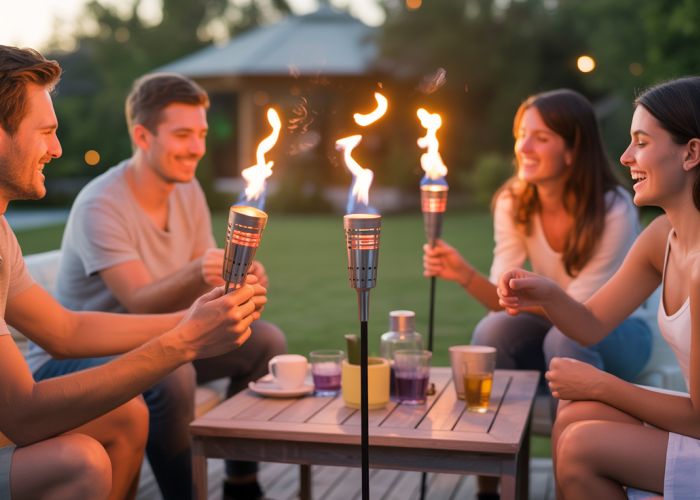Citronella oil, a common ingredient in bug repellent torches, is often marketed as an effective natural alternative to synthetic pesticides. The Environmental Protection Agency (EPA) regulates bug repellent torches to ensure consumer safety and product efficacy. While some consumers find yard torches to be aesthetically pleasing and functional for outdoor lighting, the question remains whether these bug repellent torches truly provide reliable protection against insects like mosquitoes. This article analyzes the science behind bug repellent torches and investigates their real-world effectiveness.

Best Article Layout: Bug Repellent Torches – Do They Really Work?
The optimal layout for an article answering "Bug Repellent Torches: Do They Really Work?" should prioritize clarity, objective information, and a structured presentation of facts. It needs to address the effectiveness of these torches and the factors influencing their performance.
Understanding Bug Repellent Torches
This section lays the groundwork by defining what bug repellent torches are and their intended function.
What are Bug Repellent Torches?
- Explain that these are typically outdoor torches that burn fuel (often citronella-based or infused with other insect-repelling substances).
- Describe the common designs and materials (e.g., bamboo, metal, glass containers).
- Mention common fuels used, such as citronella oil, and any other infused repellents.
How are They Supposed to Work?
- Explain the concept: The burning fuel releases insect-repelling compounds into the air.
- Describe how the smoke and scent are intended to deter bugs, primarily mosquitoes.
- Briefly introduce the idea of a "protection zone" created by the torch.
Examining the Evidence: Do They Actually Repel Bugs?
This section is the core of the article, presenting an objective analysis of the effectiveness of bug repellent torches.
Research Studies and Expert Opinions
- This is where you need to cite any scientific studies or expert opinions regarding the efficacy of bug repellent torches.
- Look for research on citronella effectiveness, the dispersal range of repellents from torches, and comparisons to other methods.
- If studies are limited or inconclusive, acknowledge this and explain the implications.
Factors Affecting Effectiveness
-
Several elements can influence how well bug repellent torches work. These should be discussed individually:
-
Type of Repellent:
- Citronella: Briefly discuss its known properties and effectiveness.
- Other Repellents: If other infused oils are used, discuss their active ingredients and known effectiveness.
- Is the fuel of sufficient quality and concentration to be effective?
-
Wind Conditions: Explain how wind can dissipate the repellent and reduce the protected area.
-
Placement of Torches: Discuss how torch placement affects the protection zone. Are they placed too far apart or too close to the seating area?
-
Bug Species: Note that some species might be more resistant to the repellents than others. Consider creating a small table like this:
Bug Species Repellency Rate (Citronella) Mosquito A 60% Mosquito B 40% Fly C 20% -
Environmental Factors: Humidity, temperature, and proximity to water sources can all impact bug populations and the effectiveness of repellents.
-
Comparing Bug Repellent Torches to Alternatives
This section provides context by comparing bug repellent torches to other methods of insect control.
Advantages of Bug Repellent Torches
- Aesthetic appeal: Many people find torches visually appealing in outdoor settings.
- Relatively low cost: Compared to some alternatives, torches can be a budget-friendly option.
- Can provide ambient lighting: The flame offers some illumination.
Disadvantages of Bug Repellent Torches
- Limited effective range: The protection zone is typically small.
- Potential fire hazard: Open flames always pose a risk.
- Environmental concerns: Burning fuel releases smoke and potential pollutants.
- Requires frequent refueling and maintenance.
- Some studies suggest citronella alone is only moderately effective.
Alternative Insect Repellent Methods
-
Briefly list alternatives, such as:
- DEET-based sprays
- Picaridin-based sprays
- Repellent diffusers (electric or battery-powered)
- Mosquito nets
- Professional pest control services
Using Bug Repellent Torches Safely and Effectively
This section offers practical advice for users who choose to use bug repellent torches.
Safety Precautions
- Never leave torches unattended.
- Keep away from flammable materials.
- Place on a stable surface.
- Supervise children and pets.
- Store fuel properly.
Maximizing Effectiveness
- Use multiple torches to increase the protected area.
- Place torches upwind of your seating area.
- Combine with other insect repellent methods.
- Consider the type of repellent and choose one known to be effective against your target pests.
- Ensure torches are properly maintained and fuel is fresh.
Bug Repellent Torches: Your Burning Questions Answered
Have questions about bug repellent torches and whether they’re effective? Here are some common questions and straight answers.
How do bug repellent torches actually work?
Bug repellent torches work by burning citronella or other insect-repelling oils. The heat vaporizes the oil, releasing the scent into the air. This scent is known to mask the odors that attract mosquitoes and other bugs, making you less noticeable.
Are bug repellent torches effective against all types of bugs?
While bug repellent torches can deter some insects, they’re most effective against mosquitoes. Their effectiveness against other pests like flies or gnats can be limited, depending on the specific repellent used in the torch.
How close do I need to be to bug repellent torches for them to work?
The effective range of bug repellent torches is limited. They work best in a relatively small radius around the torch, typically a few feet. Placing multiple torches strategically around your outdoor area can improve their overall coverage.
Are there any safety concerns when using bug repellent torches?
Yes, always exercise caution. Never leave bug repellent torches unattended. Keep them away from flammable materials and ensure they’re placed on a stable surface. As with any open flame, be mindful of fire safety.
So, have you found the perfect bug-free solution with bug repellent torches? Hopefully, you’re now armed with the knowledge to make the right choice for your outdoor adventures. Enjoy those evenings pest-free!